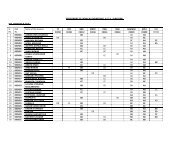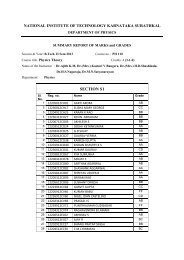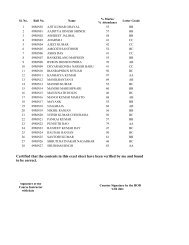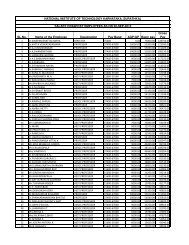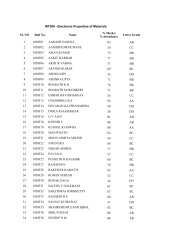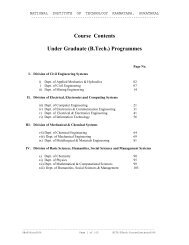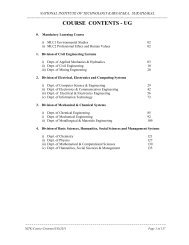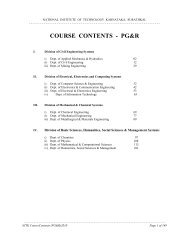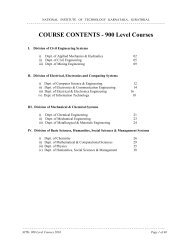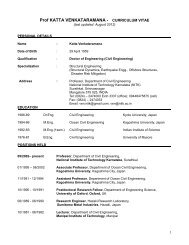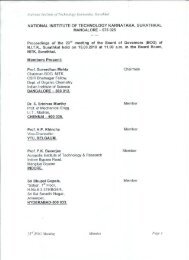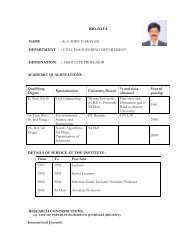course contents - ug - National Institute of Technology Karnataka
course contents - ug - National Institute of Technology Karnataka
course contents - ug - National Institute of Technology Karnataka
Create successful ePaper yourself
Turn your PDF publications into a flip-book with our unique Google optimized e-Paper software.
NATIONAL INSTITUTE OF TECHNOLOGY KARNATAKA, SURATHAKAL<br />
------------------------------------------------------------------------------------------------------------------<br />
EE418 ADVANCED POWER ELECTRONICS (3-1-0) 4<br />
Power devices, design <strong>of</strong> inductors, transformers, selection <strong>of</strong> core, design <strong>of</strong> capacitors, selection <strong>of</strong><br />
capacitors for different applications. AC to DC converters, Multilevel inverters, DC to DC converters,<br />
Hard switch converters, design and analysis, Isolated converters, resonant converters.<br />
Ned Mohan, Undeland, Robbins , Power Electronics.<br />
M. H. Rashid, Power Electronic Circuits – Devices and Applications.<br />
EE420 POWER SYSTEM DYNAMICS (3-1-0) 4<br />
Power system component modeling for dynamic studies: Synchronous generator modeling, Exciter and<br />
turbine modeling, Load modeling. System stability analysis: Angle stability (small signal and large<br />
signal), Voltage stability, Frequency stability.<br />
K.R. Padiyar, Power System Stability and Control, Interline, 1996.<br />
Prabha Kundur, Power System Stability and Control, McGraw-Hill, 1994.<br />
EE422 SWITCHGEAR AND PROTECTION (3-1-0) 4<br />
Fuses and switches, methods <strong>of</strong> earthing, Circuit Breakers: Arcs, Interruption, RRRV, Current<br />
chopping, Interruption <strong>of</strong> capacitive current, Resistance switching. Types <strong>of</strong> circuit breakers, Circuit<br />
breaker ratings, Auto reclosure. Protective relaying: Functions, Standard definitions and terminology,<br />
Fundamental characteristics. Relay classifications, Electromechanical relays. Directional relay, Reverse<br />
power relay. Differential protection schemes for bus-bars, transformers and alternators. Frame leakage,<br />
bus-bar and transformer protection. Buchholtz relay, Backup protection. Alternator protection: Negative<br />
phase sequence relay, Loss <strong>of</strong> field protection. Line protection: Overcurrent relays and schemes,<br />
Distance relays and schemes, Effect <strong>of</strong> arc resistance, Translay relaying, Carrier current relaying.<br />
Induction motor protection: Abnormal operating conditions, Undervoltage, Phase and earth fault,<br />
Overload and unbalance voltage protection. Solid state relays: Comparators, Duality between phase and<br />
amplitude comparators. General equation <strong>of</strong> comparators, Realization <strong>of</strong> directional, Ohm, reactance,<br />
impedance and Mho characteristics using the general characteristic equation, Static distance relays.<br />
Computer aided relaying: Introduction to microcomputer based relays, General functional diagram <strong>of</strong><br />
microcomputer-based relays.<br />
Ravindranath, Chander , Power System Protection and Switchgear, Wiley Eastern, 1994.<br />
C. L. Wadhwa, Electrical Power Systems, 2 nd Edition, PHI, 1993.<br />
Arun G. Phadke, S H Horowitz, Power System Relaying, 2 nd Edition, John Wiley, 1995.<br />
Badriram, D. N. Vishwakarma, Power System Protection and Switchgear, TMH, 1995.<br />
EE427 COMPUTER NETWORKS (3-0-0) 3<br />
Introduction, Physical layer, Data link, Media Access, Network layer, Transport layer, ATM,<br />
Applications.<br />
Andrew S. Tanenbaum, Computer Networks, Pearson Education.<br />
EE428 THE ARM CORE: ARCHITECTURE AND PROGRAMMING (3-1-0) 4<br />
The ARM design philosophy, ARM processor fundamentals � Registers, Current program status register,<br />
pipeline, exceptions, interrupts and the vector table, core extensions, architecture revisions, ARM<br />
processor families. The ARM instruction set: Data processing instructions, Branch instructions, Loadstore<br />
instructions, S<strong>of</strong>tware interrupt instructions, Program status register instructions, Conditional<br />
execution. The THUMB instruction set, THUMB register usage, ARM-THUMB interworking.<br />
Writing assembly code, Pr<strong>of</strong>iling and cycle counting, Instruction Scheduling, Register allocation,<br />
Looping constructs, Bit manipulation, Efficient switches, Handling unaligned data. Using the GNU<br />
assembler.<br />
Optimized primitives, Exception and interrupt handling. Rudimentary aspects <strong>of</strong> embedded operating<br />
systems.<br />
David Seal (Ed.), ARM Architecture Reference Manual, 2 nd Edition, Addison-Wesley, 2001.<br />
---------------------------------------------------------------------<br />
NITK-Course Contents(UG)2010 Page 67 <strong>of</strong> 134



